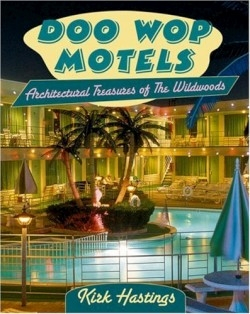
Doo Wop Motels
Architectural Treasures of the Wildwoods
On a seven-mile-long barrier island at the southern tip of New Jersey lie the four towns of Wildwood Crest, Wildwood, North Wildwood and West Wildwood. These towns are collectively known as The Wildwoods. Here, in the late 1950s the confluence of beach culture, post-war prosperity, automobile ownership, and the age of Sputnik led to an explosion of American creative motel architecture. Fun, funky, brightly lit in neon, their kidney shaped pools adorned with towering plastic palm trees, this oasis of unique architecture has been dubbed “Doo wop” after the musical style popular in the late 1950s. Hastings, a graphic artist who grew up in Wildwood Crest and is now the president of the Wildwood Crest Historical Society, has written a colorful and fascinating introduction to this unique American architectural culture.
Doo Wop Motels is composed of three distinct parts. The first is a history of Doo wop motel architecture and its sub-categories of Modern (think Jetsons), Vroom! (think implied motion), Poynesian Pop (think Disney’s Swiss Family Robinson), Phony Colonee (think Early American plantation), and Chinatown Revival (think Howard Johnsons meets Pogoda). This section of the book is fascinating and entertaining, and makes one wish for a stroll along the Doo wop beach front. In section two, Hastings brings readers up to date with the sobering vision of a decaying and fading era and the efforts to study and preserve the largest concentrated collection of mid-century Doo wop in the country. The third section shows both the demise of many of the buildings mentioned in part one, and the more positive aspects of recent attempts to preserve and expand both existing structures and neo-Doo wop styles that are emerging in new buildings.
The photographs in the book, and there are many of them, are alone worth the price of the book. These structures are pure eye candy, with swooping lines, strange angles and curves, and neon, neon, neon. The swimming pools look like something out of an animated movie and there is no better observation about early ’60s culture than this description of the Olympic Motor Inn: “Four stories, L-shaped, and similar in appearance to the Crusader Motor Inn a couple of blocks away, the Olympic, instead of a medieval knight, sported a two-dimensional, three-story-tall backlit discus thrower on the side of its western wing, painted to resemble a classic fifth century BC statue…The original figure was anatomically correct in every detail, as was the original sculpture.” Enthusiastically recommended.
Reviewed by
Peter Terry
Disclosure: This article is not an endorsement, but a review. The publisher of this book provided free copies of the book to have their book reviewed by a professional reviewer. No fee was paid by the publisher for this review. Foreword Reviews only recommends books that we love. Foreword Magazine, Inc. is disclosing this in accordance with the Federal Trade Commission’s 16 CFR, Part 255.
